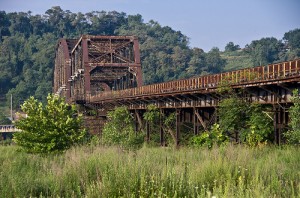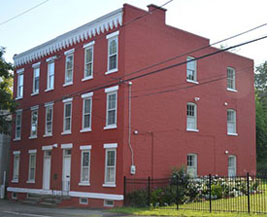Industrial Landscapes: Protecting and Interpreting Sites of Labor and Production

In order to explain industrial processes and their impacts on people and the natural world, it is often necessary to understand larger regional systems of production and consumption. Pioneering work to identify and protect linear resources such as canals and historic roads has now expanded to encompass large industrial complexes, settlements of both workers and management, inter-connected supply chains, and even sources of raw materials. Strategies for preserving industrial landscapes include the work of nonprofit associations, state and federal designations as a park, heritage area, trail or scenic byway and the role of investments schemes focused on community development or heritage tourism.
In the 1970’s and 1980’s, three states, Massachusetts, New York and Pennsylvania, established systems of urban / heritage parks focused largely (though not exclusively) on interpreting stories and protecting sites associated with labor and work. [see map] Searching for solutions to the lost tax revenue, unemployment, and population out-migration triggered by capital flight, elected officials and local activists in each jurisdiction, organized to identify, designate and promote sites associated with nineteenth and twentieth century industry. Though ultimately quite distinct in their approaches, the states all succeeded in protecting an impressive array of labor-oriented sites. Indeed, their efforts far surpass any federally-sponsored initiatives supported by the NPS or other national agencies.
Massachusetts – Manufacturing in the Bay State, which began to decline in the 1920’s, continued its downward spiral throughout the Depression and 1940’s and 1950’s, even as many parts of the country prospered economically. By the late 1960’s and early 1970’s, Massachusetts had one of the highest unemployment rates in the nation, with many cities in the double digits. In Lowell, for example, once a center of the textile production, unemployment hit 13 percent in the mid 1970’s .
One response to the loss of blue collar work was a shift towards adaptive reuse and heritage tourism – turning sites of production into sites of consumption and leisure. The first such effort to gain momentum in Massachusetts was centered in Lowell. With strong bi-partisan support, Gov. Michael Dukakis signed a bill that designated sections of the city’s downtown, as well as land adjoining the its 5.6 mile power canal system, as the state’s first official “heritage park” in 1976. Eventually, a dozen such parks would be created. Significantly, Lowell was also designated a National Historical Park in 1978, opening the door to much higher levels of funding not available to other heritage state parks. The Massachusetts sites had relatively small footprints (single neighborhood or district) and little public ownership of land or resources. These were not city parks in the Olmsted tradition, with a strict distinction between nature and culture. Rather, the cultural landscape served as the very basis for designation. Especially in the early years, labor and industry served as the primary interpretive themes, with the goal of developing tourist infrastructure, recreation and open space conservation.

New York – (for a more detailed history, click here) At roughly the same time as the Massachusetts heritage parks program took shape, a similar idea began to generate interest in neighboring New York State, where many urban areas were also suffering from job loss, capital flight and destructive attempts at urban renewal. In 1977, the legislature designated the first urban cultural park (later re-named heritage area) at the confluence of the Hudson and Mohawk Rivers north of Albany. It focused on the stories of industry, especially iron and textiles, and included 5 communities: Cohoes, Colonie, Green Island, Troy, Waterford and Watervliet.
Following 5 years of planning, including detailed surveys of many of New York’s urban areas, the state issued a detailed program plan, which included the designation of 13 additional urban cultural parks. Though the program focus remained decidedly city-oriented, it did shift away from labor to encompass a diversity of themes. As in Massachusetts, outright public ownership of land was limited, with the focus on planning and collaboration, not direct management of resources.
Pennsylvania – The third northeast state to experiment with the industrial parks model was Pennsylvania. As in Massachusetts and New York, interest in the concept began to emerge in the mid-1970s, but state officials did not take any concrete action until the early 1980’s, when a series of studies emerged on the potential for creating an urban cultural park system modeled on the New York experience.
In 1984, the state, with funding from the National Park Service, issued a detailed proposal outlining its plan for an urban cultural park system. Produced by three state agencies, the Pennsylvania Historical and Museum Commission (PHMC), the Department of Environmental Resources (DER) and the Department of Community Affairs (DCA), the report, entitled “Pennsylvania Heritage Parks: A Concept with Applications,” used a complex screening matrix to assess the relative potential for inclusion of more than forty sites, with factors such as physical integrity of resources and revitalization potential considered in the assessment.
In 1989, after roughly a decade of study and planning, Governor Robert Casey Sr. included $550,000 in his yearly budget request for the launch of the first three heritage parks. Within two years, the program’s appropriation would grow to two million dollars, with the number of sites also increasing to nine, all with an industrial focus. Eventually 12 areas would be designated, managed predominately by nonprofits or local government. In more recent, the strong industrial focus of the program has shifted to broader, more generalized heritage themes. Additionally, the Pennsylvania program has been far more regional in focus that the Massachusetts or New York efforts.
* This map is an evolving effort. If you have more information on any of the sites identified, please contact us!
Additional posts / articles:
The Story of Heritage Areas in New York
New York State Parks Agency Dropped the Ball


